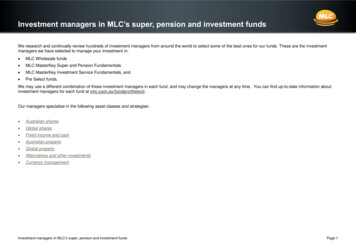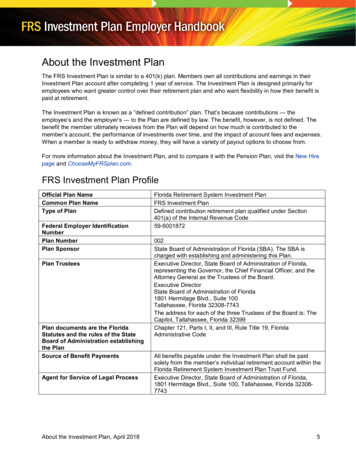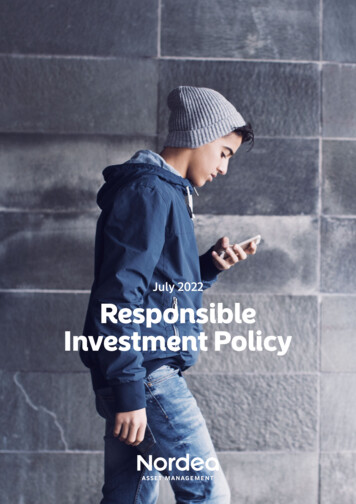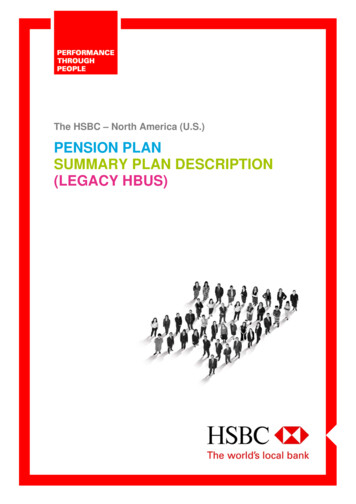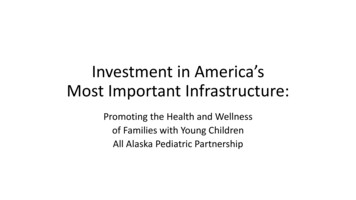
Transcription
Investment in America’sMost Important Infrastructure:Promoting the Health and Wellnessof Families with Young ChildrenAll Alaska Pediatric Partnership
Impact of Neglect2
Synapses Connections The human brain is shapedthrough neuronal connections Changes in these connections birth: 50 trillion synapses 1 year: 1,000 trillion 20 years: 500 trillion The remolded brain facilitatesefficiency and learning3
Synaptic Growth and Pruning Synaptic pruning occurs in areas that are infrequently used Results in decreased number of synapses between neurons Maximum number of synapses occurs around age 3 years old Allows for improved functionality and efficiency of synaptictransmission in the brain Plasticity (the ability to change your brain) essentially reaches adultlevels by age 10 years old4
Brain Development as a Measure of SynapseFormation5
Physiologic Response to Stressin Kids Stress without the buffering response of a strong adult relationshipcauses prolonged, brain-controlled secretion of stress hormones Cortisol, norepinephrine, epinephrine, etc. Stress responses are beneficial in the short term with adult support,but can be damaging to health if they occur over long periods of time Constant wear and tear Potentially permanent changes in gene regulation6
Epigenetics7
Childhood Epigenetic Changes Kids raised in institutional environments (Romanian orphanages) Epigenetic changes in regions of brain development Adults exposed to abuse as kids: 997 different genes had methylation patterns that were different than fromadults who were not abused Genes were involved with cell signaling pathways, brain development, immune function,stress regulation, etc. Similar results from adults from the foster care system, adults exposed toviolence as kids, adults exposed to neglect as kids 8
How Do These Epigenetic Changes AffectStressed Kids Structural brain changes: Smaller hippocampus (memory), smallercorpus callosum (connections between the hemispheres of the brain),smaller prefrontal cortex (reasoning, emotional control), largeramygdala (anxiety and release of stress hormones from the pituitary) Inflammation/immunological changes: C-reactive protein, stresscytokine levels elevated in adults with history of early adversities Endocrine changes: Dysregulation of stress hormones, decreasedoxytocin9
Epigenetics Passed from Moms to ChildrenFetal exposure to maternal stress influences future stressresponses in a negative way through epigenetics. Moms who are stressed (stressful event—famine, increased anxiety,depression) during pregnancy are more likely to have kids with: Preterm birthPoor emotional coping skillsDecreased cognitive abilitiesIncreased fear response to stimuliIncreased anxietyDecreased immune functionAutismLots of others .10
Epigenetics Passed from Dads to Sons Offspring of Civil War prisoners (4600 kids) Sons—died earlier Sons born before the war didn’t have any mortality differences Daughters—unaffected Seems to occur through transmitted RNA molecules rather thanmethylation or histone modification11
Telomeres and StressTelomeres appear to beimpacted by trauma inchildhood. Adults exposed to trauma as achild had shortened telomeres Marker of accelerated ageing anddisease12
But These Epigenetic Effects Can Be ReversedPrevention programs that result in improved family function and betterparenting skills result in: Reversal of epigenetic changes in young children Reverses the brain changes seen in adulthood Improved health outcomes Decreased mental health issues Decreased costs13
Public Investment in Children by Age14
Public Investment in Children by Brain Growth15
Econometrics of EarlyIntervention & PreventionFunding early interventions providesthe largest possible return oninvestment.Doyle et al. (2009) Investing in Early Human Development.In: Economics and Human Biology v7:pp1-616
Costs of Child Abuse: USA Over 124 billion in costs/year (Fang et al., 2012) Lifetime cost per victim of nonfatal child maltreatment is 210,012:- 144,360 productivity losses- 6,747 criminal justice costs- 32,648 childhood health care costs- 10,530 adult medical costs- 7,999 special education costs- 7,728 child welfare costs17
A Common Language to Explain Development10 adverse childhood experiences surveyed:1. Physical abuse2. Sexual abuse3. Emotional abuse4. Emotional neglect5. Physical neglect6. Witness domestic violence7. Mental illness in home8. Family member incarcerated9. Alcohol/drug problems10. Parental separation or divorce18
ACEs: Prevalence data Prevalence of ACEs in study group: Sexual abuse 21%Domestic violence in childhood home 13%Substance abuse in home 28%Parental separation or divorce 24%Physical abuse 28%Emotional neglect 15%Emotional abuse 11%Physical neglect 10%Mental illness in home 20%Criminal household member 5%M Dong et al. (2003) Child Abuse and Neglect v27, pp 625-639.19
ACEs: Adult Health Key Finding: About 2/3rd of those surveyed reported at least one ACE. The 1/3 of participants with no reported ACEs were consistently healthieracross all measures.20
ACEs Score Dose Response21
Health Measures Now Linked toAdverse Childhood Experiences ScoreStepwise increased risk for: Heart diseaseAsthmaDiabetesCancerCOPDSkeletal fracturesSexually transmitted diseasesLiver diseaseAutoimmune disordersOsteoarthritisSmokingAlcohol abuseOvereating and obesityIllicit drug usePromiscuityIV drug useClinical depressionAnd Autobiographical memory disturbancePoor anger controlRelationship problemsEmployment problemsEarly age at first intercourseTeen pregnancyUnintended pregnancyTeen paternityFetal deathSuicideDomestic violenceAnxiety disordersHallucinationsSleep disturbancesChronic painHeadachesEarly death22
ACEs: Alaska vs. 10 States23
Alaska ACEs in ChildrenAlaska Children and Youth ACEs inthe General Population.24
Alaska ACEs in Children (con’t)Alaskan Children and Youth ACEsfor those who Experienced LowIncome.25
Alaska ACEs in Children (more)Alaskan Children and Youth ACEsfor those who Witness DomesticViolence.26
Age When US Kids Accumulate Half of TheirLifetime ACEs27
CostsAlaskan adults who report four or more ACEs compared to Alaskanadults who report zero ACEs. 49% more likely to be unemployed 274% more likely to be unable to work 92% more likely to earn less than 20,000 annuallySource: 2013 Alaska Behavioral Risk Factor Surveillance System, Analysis by Alaska Mental Health Board/Advisory Board onAlcoholism and Drug Abuse Staff28
Population Attributable Risks in Alaska29
Alaskan ACEs Compared to Two Other files/documents/2016/12/summary brfss m5949a1.htm30
Alaskan ACEs with a One-Half ACE ReductionCompared to Two Other files/documents/2016/12/summary brfss m5949a1.htm31
Reducing Alaska’s ACE Score by ½ Point If we just look at the reduction of ObesityAdult Medicaid recipientsSmokingBinge drinkingDiabetesArthritis Alaska will save 90 million annually32
Estimated Reduction in Number of Alaskan Adultsfor Economic and Educational OutcomesCalculations based on 2013 Alaska BRFSS data conducted be the Alaska Mental Health Board and Advisory Board onAlcoholism and Drug Abuse Staff33
Estimated Reduction in Number of AlaskanAdults for Behavioral Health OutcomesCalculations based on 2013 Alaska BRFSS data conducted be the Alaska Mental Health Board and Advisory Board onAlcoholism and Drug Abuse Staff34
Estimated Reduction in Number of AlaskanAdults for Food Insecurity OutcomesCalculations based on 2013 Alaska BRFSS data conducted be the Alaska Mental Health Board and Advisory Board onAlcoholism and Drug Abuse Staff35
How Do We Identify These Kids?36
What We’re Really Talking About Is .ConversationsThis means we ask the question, “Let’s have a conversation .” ratherthan “What’s wrong with you?” This fundamentally changes the way we interact with people Changes an interaction with a family from “I must fix you” to “I will listen toyou”37
Behaviors Associated with Early ChildhoodTraumaAges: 0-2 Dysregulated eating, sleepingpatterns Developmental regression Irritability, sadness, anger Poor appetite, low weight gain Increased separation anxiety,clinginess https://www.ecmhc.org/tutorials/trauma/mod3 1.html dtreating-child-traumatic-stressAges 3-6 Increased aggressionSomatic symptomsSleep difficulties/nightmaresIncreased separation anxietyNew fearsIncreased distractibility/high activitylevelIncreased withdrawal/apathyDevelopmental regressionRepetitive talk/play about the eventIntrusive thoughts, memoriesAbsenteeism38
Four Questions—Gets Almost Everything Has anything really stressful happened to your child since the lasttime I saw you? How has that affected your child’s behavior? Corollary question: How has this event and any changes in your child’sbehavior affected you? What have you done that you’ve enjoyed with your child since thelast time I saw you? Give me three words that describe your child to you.39
Resilience to ACEsThe most important protectiveresource to enable a child to copewith exposure to violence is astrong relationship with acompetent, caring, positive adult,often a parent—but doesn’t haveto be!40
Resilience—Ordinary MagicWith the support of goodparenting by either a parent orother significant adult, a child’scognitive and social developmentcan proceed positively even withadversity.41
If a Traumatic Stressor Is Identified: Assess for child and family safety Provide education/guidance about behavior management, routinesand daily living activities to promote recovery and sense of safety Refer to social work, child protection, domestic violence team or formental health intervention, if needed Alaska Child Trauma Center Help Me Grow Alaska42
So .Where Is the Best Place to Focus SocietyEfforts to Improve Family Health?Data from the National Survey onChildren’s Health (2011-12)combining ACEs data with chronicchild health outcomes andoverlaying environmental changesto see if there is an effect.43
Effect of Neighborhood Amenities on ChildHealth1.2.3.4.SidewalksParksRecreational CenterLibrary44
Effect of Neighborhood Amenities on ChildHealth (con’t)45
Effect of Neighborhood Detracting Elementson Child Health1. Litter or garbage about2. Dilapidated housing3. Broken windows or graffiti46
Effect of Neighborhood Detracting Elementson Child Health (con’t)47
Effect of Neighborhood Cohesion on ChildHealth1.2.3.4.People help each other outPeople watch each other’s childrenPeople to count onAdults I can trust48
Effect of Neighborhood Cohesion on ChildHealth (con’t)49
Effect of Self-Regulation Skills onChild Health1. Finishes tasks and follows through on commitments2. Stays calm and in-control when facing a challenge3. Shows interest and curiosity in learning new things50
Effect of Self-Regulation Skills onChild Health (con’t)51
Self-Regulation: ARC Framework Attachment Caregiver affect management Attunement Consistent response Regulation Identification Modulation Expression Competency Executive function Self development Alaska Child Trauma Center—training availablefor organizations to implement ARC lyservices/alaska-child-trauma-center52
Foundations of Healthy Development Healthy relationships Consistent Nurturing Protective Healthy environment Free from toxins Safe and active exploration Healthy nutrition Breastfeeding support Maternal nutrition** **Traditional diet53
Systems Changes54
SB 105 (2018)It is the policy of the state to acknowledge and take into account theprinciples of early childhood and youth brain development and,whenever possible, consider the concepts of early adversity, toxicstress, childhood trauma, and the promotion of resilience throughprotective relationships, supports, self-regulation, and services.55
New Generations Project AimAlaska Native families will increasetheir physical, mental, emotionaland spiritual wellness by optimizingthe effectiveness of services thatsupport families in the preparationfor and care of new generations byinventorying current work, learningfrom internal and external bestpractices, engaging SCF andcommunity stakeholders andcreating a coordinated, systemapproach to be deployed byDecember 2023.56
Prevention and Promotion Strategies57
Alaska’s Comprehensive IntegratedMental Health Program Plan 2020-2458
Alaskan Mental Health Program PlanThe plan can be s/MentalHealth/default.aspx59
Goal 1 (Early Childhood)Programs Serving Young Children Promote Resiliency, Preventand Address Trauma, and Provide Access to Early CompPlan Goal1 2020-24.pdf60
Goal 1 (Early Childhood), Objectives: 1.1 Objective: Promote practice-informed, universal screening effortsand early intervention services. 1.2 Objective: Provide ongoing support to ensure accurateidentification and treatment of social-emotional needs for childrenand their caregivers, congruent with their cultural identification. 1.3 Objective: Reduce the instances and impact of Adverse ChildhoodExperiences (ACEs) through community engagement and byimproving social determinants of health.61
APIA Head Start62
Transforming SchoolsIntegrates school-wide, traumaengaged approach to improveacademic outcomes and wellbeing for all students usingstories, research, and -Practice-Final.pdf63
Building an Agenda for Families Support systems of Primary Care Medicaid 1115 Waiver Mental health provider in all clinics Childcare and early education Universal, high-quality childcare Alaska SB 6 Family economic stability Including employment support for parents Paid parental leave Flexible work hours to attend school activities Community development Including zoning regulations that influence the availability of open spaces and sources of nutritious food Housing Environmental protection64
Building an Agenda for Families (con’t) Support food security for families The Children’s Lunchbox Food Bank of Alaska Support programs that train caregivers and parents to care for their children Strengthening Families and Positive Parenting Program Support affordable, high-quality childcare for all families so that parents maywork without compromising their child’s development Thread Support the development of trauma-informed schools Transforming Schools: A Framework for Trauma Informed Practice in Alaska Juneau Trauma-Informed Schools Pilot Project Support a safe place for kids to go after school Campfire Alaska65
Building an Agenda for Families (more) Support improved mental health services for families in all areas ofAlaska Judge Vanessa White’s Court in Palmer Alaska Child Trauma Center Support safe housing for families Support a living wage and ongoing training for teachers, Head Startworkers, and childcare workers In general . Intensive intervention and support for families at high risk of experiencingtoxic stress!!!66
Basically .Families with young children are theinfrastructure of Alaska, and there’snothing more important to Alaska’ssuccessful future.67
Thank you!!!Matthew Hirschfeld MD/PhDBoard MemberAll Alaska Pediatric Partnershipmhirschfeld@scf.ccwww.a2p2.org68
Epigenetics Passed from Moms to Children . Epigenetics Passed from Dads to Sons Offspring of Civil War prisoners (4600 kids) . strong relationship with a competent, caring, positive adult, often a pare


